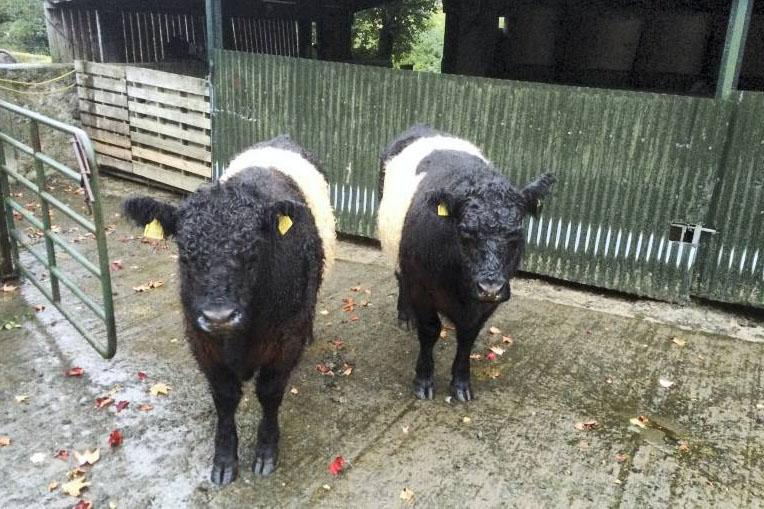We are grass farmers who sell lamb and beef. On top of this, in the last few years, we have started to calve cows. Initially it started off as an idea to get nice pedigree continental cows.
The theory was that we had the facilities and grass available, and it would be nice to breed and sell pedigree stock. This would also boost the annual income.
Having chatted to various people, we decided against a continental breed for a few reasons, mainly due to labour and the cost of keeping such big pedigree animals. Additionally, there are substantial pedigree herds of these animals servicing this market already.
Hardy and easy to keep
Upon further research, we decided on the Belted Galloway. They are a hardy, easy-to-keep, no-nonsense breed that can provide substantial return from little inputs. The reason I am explaining all of this is that now, after a number of years breeding them, we can give a good overview of their merits.
So far, I have only good things to say about the Belted Galloway cow. Our ICBF report came through recently and for four out of five key performance indicators (KPIs), the cows are performing well:
385-day calving interval (with the national average beef calving interval being 407 days);0% mortality at birth;0% mortality at 28 days;0.95 calf per cow per year.The only place where we fall down on is the age of heifers at calving. The reason for this is that a lot of our herd, being newly established, were bought in and sourced in Scotland. Because of the climate and the land belties are kept on, they do not want them calving as young as we would here. This is being rectified as time progresses.
Now to get back to why we chose belties, we are as I said grass farmers. We try to finish all of our lambs and beef off grass. We don’t have a diet feeder nor do we want one.
Results
We want a cow that could live outdoors year-round, feed herself and produce pedigree breeding animals that we could genuinely sell as grass-reared. The surplus could be finished for beef from that same grazed grass. The justification for our choice of cow has really come to fruition in the last few months as we have started to slaughter these cattle.
They have averaged 525kg liveweight at 22 months and 295kg dead weight, a 56% kill-out. All graded R and were 3- or better for fat from grazed grass.
As I write this, the cows are starting to calve again. I know every farm has a different system, but as far as I understand it, grass is and will be our cheapest fodder source. It is therefore vital we choose a cow to suit this system. So far, we are delighted with our choice.
We are grass farmers who sell lamb and beef. On top of this, in the last few years, we have started to calve cows. Initially it started off as an idea to get nice pedigree continental cows.
The theory was that we had the facilities and grass available, and it would be nice to breed and sell pedigree stock. This would also boost the annual income.
Having chatted to various people, we decided against a continental breed for a few reasons, mainly due to labour and the cost of keeping such big pedigree animals. Additionally, there are substantial pedigree herds of these animals servicing this market already.
Hardy and easy to keep
Upon further research, we decided on the Belted Galloway. They are a hardy, easy-to-keep, no-nonsense breed that can provide substantial return from little inputs. The reason I am explaining all of this is that now, after a number of years breeding them, we can give a good overview of their merits.
So far, I have only good things to say about the Belted Galloway cow. Our ICBF report came through recently and for four out of five key performance indicators (KPIs), the cows are performing well:
385-day calving interval (with the national average beef calving interval being 407 days);0% mortality at birth;0% mortality at 28 days;0.95 calf per cow per year.The only place where we fall down on is the age of heifers at calving. The reason for this is that a lot of our herd, being newly established, were bought in and sourced in Scotland. Because of the climate and the land belties are kept on, they do not want them calving as young as we would here. This is being rectified as time progresses.
Now to get back to why we chose belties, we are as I said grass farmers. We try to finish all of our lambs and beef off grass. We don’t have a diet feeder nor do we want one.
Results
We want a cow that could live outdoors year-round, feed herself and produce pedigree breeding animals that we could genuinely sell as grass-reared. The surplus could be finished for beef from that same grazed grass. The justification for our choice of cow has really come to fruition in the last few months as we have started to slaughter these cattle.
They have averaged 525kg liveweight at 22 months and 295kg dead weight, a 56% kill-out. All graded R and were 3- or better for fat from grazed grass.
As I write this, the cows are starting to calve again. I know every farm has a different system, but as far as I understand it, grass is and will be our cheapest fodder source. It is therefore vital we choose a cow to suit this system. So far, we are delighted with our choice.






 This is a subscriber-only article
This is a subscriber-only article














SHARING OPTIONS: